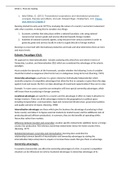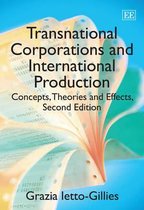Week 1: Must do reading
1. Ietto-Gillies, G. (2012) Transnational corporations and international production:
concepts, theories and effects, 2nd edn, Edward Elgar, Cheltenham, U.K. Please
click here for Chapter 9
Dunning started his early work (1977) by analysing the nature of a country’s economic involvement
with other countries. In doing this he considers two things:
1. Economic activities that take places within a national boundary, only using national
resources but concern goods and services directed towards foreign markets
2. Activities of national economic agents, using resource from various countries in order to
generate goods and services locally in order to supply directly to foreign markets
Dunnings is concerned with international production and trade and what determines them at micro
and macro levels.
Eclectic Paradigm (OLI):
His approach to internationalisation includes analysing why when/how and where in terms of
Ownership, Location, and Internalisation (OLI) which are considered the advantages of his eclectic
paradigm.
Must consider the dynamics of the framework, consider whether the following 3 sets of variables
should be treated as exogenous (short-term/run) or endogenous (Long-term/run) (Dunning, 1993).
Ownership advantages a particular to a given enterprise (individually/independently) which
normally comprise of competitive advantages that allow the firm to compete or gives them the edge
against rivals and means the firm can take advantage of investment opportunities if they are to arise.
Example: ‘In some cases a countries own enterprise will have special ownership advantages, which
will favour them in producing in foreign countries.’
Locational advantages are specific to a country and the advantages it offers to make it attractive to
foreign investors. These are all the advantages related to the geographical or political space
including transportation, communication, legal and commercial infrastructure, government policies
and quality and price of inputs. (Dunning, 1980)
Internalisation advantages are those which give the business the advantage of producing in their
home country and allow it to bypass external markets (& market issues) and the additional costs of
producing abroad (offshore production). In summary, they are the benefits of operating within
hierarchies rather than markets.
Difference between location and ownership: Location specific endowments (abilities) favour a foreign
country (for production/ FDI) whereas ownership endowments favour the home country firms.
(Dunning, 1977)
Relationship between ownership and internalisation: Dunning does underline the
relationship/common benefit of internalisation and ownership advantages by stating the
internalisation helps enterprises to acquire or increase those assets that give them an advantage.
Ownership advantages:
A countries characteristic can affect the ownership advantages of a firm. A country’s competitive
situation can be influenced not only by locational advantages & ownership advantages of its





